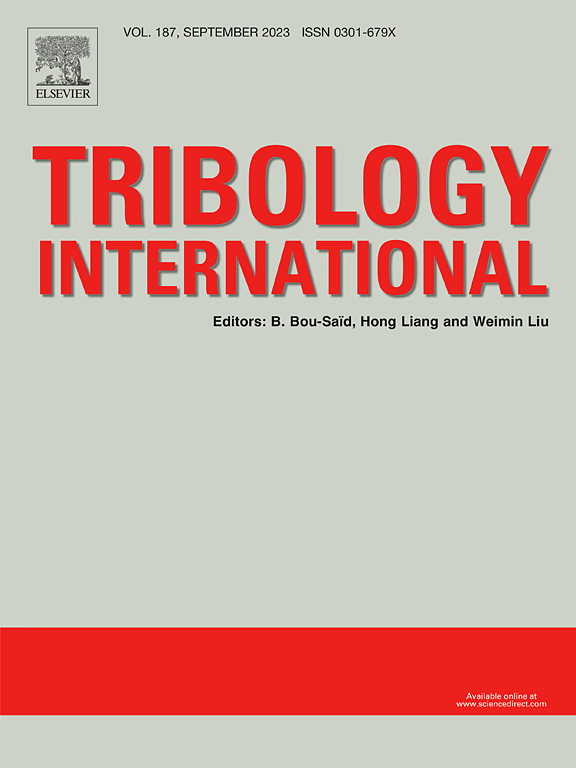在 MoS2 作为航空航天应用固体润滑剂的作用下,开放和封闭纹理 Ti-3Al-2.5V 的摩擦学性能
IF 6.1
1区 工程技术
Q1 ENGINEERING, MECHANICAL
引用次数: 0
摘要
在本研究中,使用氧化锆反面对钛合金的摩擦和磨损行为进行了研究。使用纳秒激光在 Ti-3Al-2.5V 基材上制作圆形和 S 形表面形态。使用三维轮廓仪和场发射扫描电子显微镜研究了纹理烧蚀的纹理轮廓,并使用通用摩擦磨损仪研究了纹理图案的摩擦系数和磨损性能。在 Ti3Al-2.5-V 基材上制作了长度为 100 微米的圆形纹理和长度为 360 微米、宽度为 200 微米的 "S "型纹理。制作纹理所用的激光参数包括激光功率、扫描速度和激光频率,分别为 10 瓦、350 毫米/秒和 10 千赫。在添加了 1%(重量)MoS2 颗粒的原 PAO4 润滑剂的作用下,对烧蚀的钛合金表面进行了 100 米滑动距离的摩擦和磨损测试。结果显示,圆形和 "S "纹理的烧蚀深度分别为 15.02 微米和 20.48 微米。在使用原始 PAO4 + 1 % MoS2 进行润滑时,两种纹理的摩擦系数都有所降低。当载荷从 30N 增加到 75N 时,圆形纹理的摩擦系数从 0.0441 降到 0.0382,而 "S "纹理的摩擦系数几乎保持不变,从 0.0699 降到 0.0641。在原生 PAO4 润滑油中添加 MoS2 颗粒后,"S "纹理的摩擦系数降低了 50%,表现优于圆形纹理。就耐磨性而言,在润滑油中添加 1% 重量比的 MoS2 颗粒时,在润滑过程中可能出现的接触情况下,开放式纹理轮廓最有前途。本文章由计算机程序翻译,如有差异,请以英文原文为准。
Tribological performance of open and closed textured Ti-3Al-2.5V under effect of MoS2 as solid lubricant for aerospace applications
Titanium alloys in the present study are studied for friction and wear behaviour using zirconia counter face. Nanosecond laser was used to fabricate circular and S-shape surface morphologies on Ti-3Al-2.5V substrates. The textured profiles are studied using 3D profilometer and field emission scanning electron microscope for texture ablation and universal tribometer is used to study the friction coefficient and wear behaviour of textured patterns. Friction and wear performance of textured surfaces are studied at applied load of 30, 45, 60 and 75 N. Circular textures of 100 µm while “S” textures of 360 µm length and 200 µm width are fabricated on Ti3Al-2.5-V substrates. Laser parameters used to create textures are laser power, scanning speed and laser frequency of 10-Watt, 350 mm/s and 10 KHz respectively. Friction and wear tests are performed on ablated titanium alloy surfaces for a siding distance of 100 m under the effect of virgin PAO4 lubricant with addition of 1 % by weight MoS2 particles. The results showed an ablation depth of 15.02 µm and 20.48 µm for circular and “S” textures respectively. Both the textured a reduced friction coefficient when lubricated with virgin PAO4 + 1 %MoS2. At an increasing load from 30 to 75N, friction coefficient decreased from 0.0441 to 0.0382 for circular textures while it almost remained constant from 0.0699 to 0.0641 for “S” textures. “S” textures outperformed circular profiles by reducing friction coefficient by 50 % when MoS2 particles are added in virgin PAO4 lubricating oil. In terms of wear resistance, open texture profiles were the most promising in contact situations likely to occur in lubrication when 1 % by weight MoS2 particles were added into lubricant.
求助全文
通过发布文献求助,成功后即可免费获取论文全文。
去求助
来源期刊

Tribology International
工程技术-工程:机械
CiteScore
10.10
自引率
16.10%
发文量
627
审稿时长
35 days
期刊介绍:
Tribology is the science of rubbing surfaces and contributes to every facet of our everyday life, from live cell friction to engine lubrication and seismology. As such tribology is truly multidisciplinary and this extraordinary breadth of scientific interest is reflected in the scope of Tribology International.
Tribology International seeks to publish original research papers of the highest scientific quality to provide an archival resource for scientists from all backgrounds. Written contributions are invited reporting experimental and modelling studies both in established areas of tribology and emerging fields. Scientific topics include the physics or chemistry of tribo-surfaces, bio-tribology, surface engineering and materials, contact mechanics, nano-tribology, lubricants and hydrodynamic lubrication.
 求助内容:
求助内容: 应助结果提醒方式:
应助结果提醒方式:


